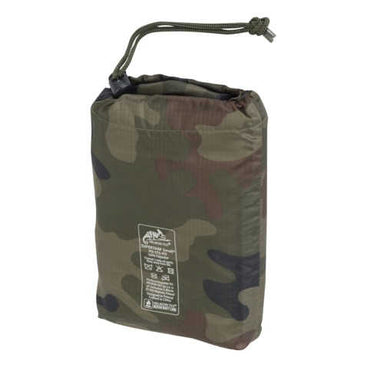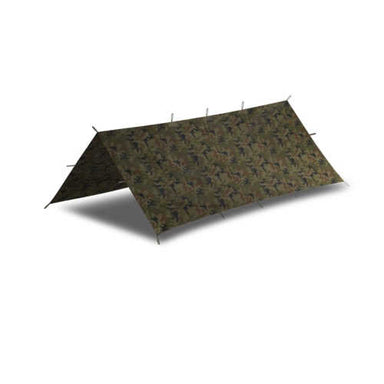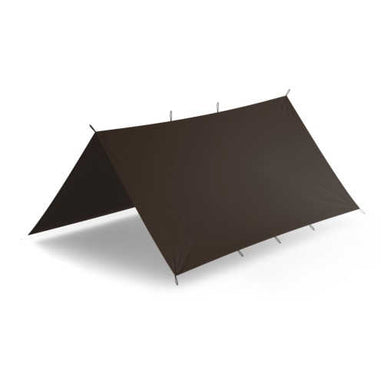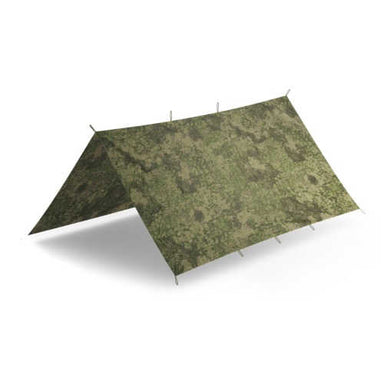

Helikon-Tex | SUPERTARP | Small
Building a shelter in the wild is crucial if you want to survive any harsh weather conditions. The Helicon-Tex SUPERTARP SMALL is the perfect item...
View full detailsTarp shelters are versatile, lightweight, and cost-effective alternatives to traditional tents, offering outdoor enthusiasts and survivalists a practical way to create temporary shelter in various environments.
These shelters are made from waterproof or water-resistant materials like polyethylene, nylon, or canvas, and can be set up quickly using minimal equipment.
Versatility: Tarp shelters can be configured in multiple ways to suit different weather conditions, terrains, and group sizes.
Lightweight: Compared to tents, tarps are often lighter, making them easier to carry during hiking, backpacking, or emergency situations.
Cost-Effective: Tarps are generally more affordable than traditional tents, making them accessible for budget-conscious campers and outdoor enthusiasts.
Customization: Users can adjust tarp shelters to maximize ventilation, weather protection, and space according to their needs.
Lean-to: A simple shelter formed by suspending one edge of the tarp between two anchor points (trees, poles, or stakes) and sloping it downward.
A-Frame: Similar to a lean-to but with both ends of the tarp anchored, creating an A-shaped structure that provides more headroom and protection.
Diamond Fly: The tarp is set up in a diamond shape, with the corners tied to trees or poles and the sides staked down to create a low-profile shelter.
Plow Point: Four corners of the tarp are tied to anchor points, with the center raised to create a raised peak, resembling a tent structure.
Material: Select a tarp made from durable, waterproof or water-resistant materials such as silnylon (silicone-coated nylon), polyethylene, or PVC-coated fabrics.
Size: Choose a tarp size based on the number of occupants and gear storage needs. Common sizes range from 8x10 feet to 10x12 feet for individual or small group shelters.
Weight: Consider the weight of the tarp, especially if you plan to carry it in a backpack. Lighter materials like silnylon are ideal for backpacking.
Attachment Points: Look for tarps with reinforced grommets, loops, or tie-out points along the edges for secure anchoring and setup flexibility.
Site Selection: Choose a flat, well-drained area away from potential hazards like falling branches or flood-prone areas.
Anchor Points: Use trees, trekking poles, rocks, or stakes to anchor the corners and edges of the tarp securely.
Weather Considerations: Orient the tarp to provide maximum protection against prevailing winds, rain, or sun exposure.
Pitching Techniques: Practice different pitching techniques (lean-to, A-frame, etc.) before your trip to familiarize yourself with setup variations and configurations.
Additional Weatherproofing: Consider using a groundsheet or footprint under the tarp to protect against ground moisture and enhance comfort.
Maintenance: Clean and dry the tarp thoroughly after each use to prevent mold and prolong its lifespan. Store it loosely rolled or folded in a dry, ventilated space.
Tarp shelters provide flexible and efficient solutions for outdoor shelter needs, offering adaptability, affordability, and simplicity in various camping and survival scenarios. By understanding their setup techniques, materials, and advantages, you can effectively utilize a tarp shelter to enhance your outdoor experience and preparedness.

 Save Liquid error (snippets/product-badge line 32): Computation results in '-Infinity'%
Save Liquid error (snippets/product-badge line 32): Computation results in '-Infinity'%
Building a shelter in the wild is crucial if you want to survive any harsh weather conditions. The Helicon-Tex SUPERTARP SMALL is the perfect item...
View full details
 Save Liquid error (snippets/product-badge line 32): Computation results in '-Infinity'%
Save Liquid error (snippets/product-badge line 32): Computation results in '-Infinity'%
Helikon-Tex has created a universal shelter cape for bivouac, bushcraft, and minimalists alike! Introducing the Helikon Tex SuperTarp! The Helikon...
View full details
